A Review of Radiative Heat Transfer in Fixed-Bed Particle Solar Receivers
Abstract
1. Introduction
2. Types of High-Temperature Fixed-Bed PSRs
- 1.
- Semi-transparent PSRs
- 2.
- Opaque PSRs
- 3.
- Mixed PSRs
3. Radiative Heat Transfer Characteristics
3.1. Models of Radiative Heat Transfer
- 1.
- Surface Radiative Heat Exchange
- 2.
- Medium Radiative Heat Transfer
3.2. Simulation Methods of Radiative Heat Transfer
4. Progress of Radiative Heat Transfer Investigations
4.1. Radiative Properties of the Large Solid Particles
- 1.
- Semi-transparent Particles
- 2.
- Opaque particles
4.2. Approaches of the Incident Solar Radiation
- 1.
- Surface Absorption Model
- 2.
- Exponential Decay Model
- 3.
- Volumetric Absorption Model
4.3. Approaches of the Radiative Heat Exchange
4.3.1. Discrete Particle Model
- 1.
- Radiative Effective Thermal Conductivity Method
- 2.
- Discrete ordinates Method
- 3.
- Surface-to-surface Radiation Method
4.3.2. Continuous Particle Model
4.4. Overall Thermal Performances of the Fixed-Bed PSRs
5. Operating Principle and Heat Transfer Characteristics
5.1. Charging and Discharging of the Fixed-Bed PSRs
5.2. Heat Transfer Characteristics of the Fixed-Bed PSRs
5.3. Advantages and Disadvantages of the Fixed-Bed PSRs
- Realize the gradient absorption of the incident solar radiation to enhance the volumetric effect, and produce higher thermal efficiency and outlet temperature [12,18]. However, the fluidized-bed PSR cannot absorb the CSF with an increasing absorption coefficient due to its flow character, despite the fluidized solid particles directly absorbing the CSF inside the quartz tube [136,137,138].
- The heat transfer from the fixed-bed particles to the HTF is feasible via direct contact. Thereby the fixed-bed PSRs are capable of eliminating the additional heat transfer resistance from particle/fluid heat exchangers. Nevertheless, the particle/fluid heat exchangers are essential in the fluidized-bed PSR system [139,140].
- The sphere particles may be ablated and fractured due to the obvious temperature difference between the interior and the surfaces subjected to the highly concentrated solar flux [18].
- The sphere particles would be abrased and deformed during longtime absorption of the CSF, convective heat transfer with HTF and the conveying operation [8].
6. Challenges and Future Directions
- 1.
- Innovative Design Method
- Minimizing reflection losses of the incident solar radiation.
- Enhanced heat transfer between the gaseous fluid and solid phase.
- Inhibiting re-radiation losses emitted from the high-temperature receiver.
- Improved Experimental Approach
- The radiative properties of solid particles should be accumulated continually and the law of degradation of radiative properties in relation to temperature and cycle time should be established.
- A comprehensive experimental scheme should be proposed to measure the overall thermal performances of fixed-bed PSRs under high temperature.
- The key performances (e.g., thermal efficiency and the outlet temperature) of the experimental approach, as well as their preconditions need to be defined more clearly.
- Effective Simulation Method
- An effective pore-scale simulation method should be developed to produce the best balance between accuracy and computational cost.
- A proper criterion for extracting the representative section used for the pore-scale simulation should be further investigated to simplify the computational domain.
- RTE simulation methods need to be improved to save computation labor and to meet the variation of radiative properties with temperature.
7. Conclusions
Author Contributions
Funding
Institutional Review Board Statement
Informed Consent Statement
Data Availability Statement
Acknowledgments
Conflicts of Interest
Nomenclature
| fitting coefficient obtained experimentally | |
| area (m2) | |
| radiation distribution factor | |
| radiation energy carried by each solar ray | |
| incident radiation | |
| radiant intensity (W sr−1 m2) | |
| Radiosity (W m−2) | |
| Rosseland diffusion coefficient. | |
| total number of the surface elements | |
| the number of the solar ray absorbed by control unit i | |
| net radiative heat flux of the surface element (W m−2). | |
| radiative heat absorbed by element i | |
| particle temperature (K) | |
| absolute temperature(K) | |
| refractive index | |
| radius of the receiver | |
| distance between two particles(m) | |
| transmission direction | |
| view factor between two particles | |
| penetration depth of the incoming solar radiation | |
| emissivity of the surface element | |
| absorbing coefficient | |
| radiative effective thermal conductivity | |
| density of the bed | |
| Stefan–Boltzmann constant (5.67 × 10−8 W m−2 K4) | |
| scattering coefficient | |
| scattering phase function(sr−1) | |
| view factor | |
| solid angle (sr) | |
| quadrature weights associated with the direction | |
| Subscripts | |
| i | volume element i |
| j | volume element j |
| k | surface element k |
| l | surface element l |
| li | from surface element l to element i |
| Abbreviations | |
| CO2 | carbon dioxide |
| CSP | concentrated solar power |
| CSF | concentrated solar flux |
| DEM | discrete element method |
| FTIR | Fourier Transform Infrared Spectrometer |
| H2O | water vapor |
| HTF | heat transfer fluid |
| MCRT | Monte Carlo Ray Tracing |
| PSRs | particle solar receivers |
| RTE | radiative transfer equation |
| TES | thermal energy storage |
| Greek symbols | |
| extinction coefficient | |
| surface | |
| volume of control unit i | |
| radiative source term | |
References
- Ávila-Marín, A.L. Volumetric receivers in Solar Thermal Power Plants with Central Receiver System technology: A review. Sol. Energy 2011, 85, 891–910. [Google Scholar] [CrossRef]
- Cagnoli, M.; Froio, A.; Savoldi, L.; Zanino, R. Multi-scale modular analysis of open volumetric receivers for central tower CSP systems. Sol. Energy 2019, 190, 195–211. [Google Scholar] [CrossRef]
- Sedighi, M.; Padilla, R.V.; Taylor, R.A.; Lake, M.; Izadgoshasb, I.; Rose, A. High-temperature, point-focus, pressurised gas-phase solar receivers: A comprehensive review. Energy Convers. Manag. 2019, 185, 678–717. [Google Scholar] [CrossRef]
- Avila-Marin, A.L.; Fernandez-Reche, J.; Martinez-Tarifa, A. Modelling strategies for porous structures as solar receivers in central receiver systems: A review. Renew. Sustain. Energy Rev. 2019, 111, 15–33. [Google Scholar] [CrossRef]
- Ho, C.K.; Iverson, B.D. Review of high-temperature central receiver designs for concentrating solar power. Renew. Sustain. Energy Rev. 2014, 29, 835–846. [Google Scholar] [CrossRef]
- Deng, Y.; Sabatier, F.; Dewil, R.; Flamant, G.; Le Gal, A.; Gueguen, R.; Baeyens, J.; Li, S.; Ansart, R. Dense upflow fluidized bed (DUFB) solar receivers of high aspect ratio: Different fluidization modes through inserting bubble rupture promoters. Chem. Eng. J. 2021, 418, 129376. [Google Scholar] [CrossRef]
- Ho, C.K. A review of high-temperature particle receivers for concentrating solar power. Appl. Therm. Eng. 2016, 109, 958–969. [Google Scholar] [CrossRef]
- Sedighi, M.; Taylor, R.A.; Padilla, R.V. Experimentally validated pore-scale numerical analysis for high-temperature (>700 °C), high-efficiency (>90%) volumetric solar receivers. Energy Convers. Manag. X 2021, 12, 100127. [Google Scholar] [CrossRef]
- Calderón-Vásquez, I.; Cortés, E.; García, J.; Segovia, V.; Caroca, A.; Sarmiento, C.; Barraza, R.; Cardemil, J.M. Review on modeling approaches for packed-bed thermal storage systems. Renew. Sustain. Energy Rev. 2021, 143, 110902. [Google Scholar] [CrossRef]
- Partopour, B.; Dixon, A.G. Integrated multiscale modeling of fixed bed reactors: Studying the reactor under dynamic reaction conditions. Chem. Eng. J. 2019, 377, 119738. [Google Scholar] [CrossRef]
- Sedighi, M.; Padilla, R.V.; Lake, M.; Rose, A.; Lim, Y.Y.; Novak, J.P.; Taylor, R.A. Design of high-temperature atmospheric and pressurised gas-phase solar receivers: A comprehensive review on numerical modelling and performance parameters. Sol. Energy 2020, 201, 701–723. [Google Scholar] [CrossRef]
- Sedighi, M.; Padilla, R.V.; Alamdari, P.; Lake, M.; Rose, A.; Izadgoshasb, I.; Taylor, R.A. A novel high-temperature (>700 °C), volumetric receiver with a packed bed of transparent and absorbing spheres. Appl. Energy 2020, 264, 114705. [Google Scholar] [CrossRef]
- Wang, F.Q.; Ma, L.X.; Cheng, Z.M.; Tan, J.Y.; Xing, H.; Liu, L.H. Radiative heat transfer in solar thermochemical particle reactor: A comprehensive review. Renew. Sustain. Energy Rev. 2017, 73, 935–949. [Google Scholar]
- Modest, M. Radiative Heat Transfer, 3rd ed.; Academic Press: San Diego, CA, USA, 2013. [Google Scholar]
- Zaversky, F.; Aldaz, L.; Sánchez, M.; Ávila-Marín, A.L.; Roldán, M.I.; Fernández-Reche, J.; Füssel, A.; Beckert, W.; Adler, J. Numerical and experimental evaluation and optimization of ceramic foam as solar absorber—Single-layer vs multi-layer configurations. Appl. Energy 2018, 210, 351–375. [Google Scholar] [CrossRef]
- Kribus, A.; Gray, Y.; Grijnevich, M.; Mittelman, G.; Mey-Cloutier, S.; Caliot, C. The promise and challenge of solar volumetric absorbers. Sol. Energy 2014, 110, 463–481. [Google Scholar] [CrossRef]
- Dong, Y.; Sosna, B.; Korup, O.; Rosowski, F.; Horn, R. Investigation of radial heat transfer in a fixed-bed reactor: CFD simulations and profile measurements. Chem. Eng. J. 2017, 317, 204–214. [Google Scholar] [CrossRef]
- Sedighi, M.; Vasquez Padilla, R.; Taylor, R.A. Efficiency limits of high-temperature transparent packed-bed solar receivers. Energy Convers. Manag. 2021, 241, 114257. [Google Scholar] [CrossRef]
- Karni, J.; Kribus, A.; Ostraich, B.; Kochavi, E. A high-pressure window for volumetric solar receiver. J. Sol. Energy Eng. 1998, 120, 101–107. [Google Scholar] [CrossRef]
- Wang, F.Q.; Tan, T.Y.; Ma, L.X.; Shuai, Y.; Tan, H.P.; Leng, Y. Thermal performance analysis of porous medium solar receiver with quartz window to minimize heat flux gradient. Sol. Energy 2014, 108, 348–359. [Google Scholar]
- Dai, G.-L.; Xia, X.-L.; Hou, G.-F. Transmission performances of solar windows exposed to concentrated sunlight. Sol. Energy 2014, 103, 125–133. [Google Scholar] [CrossRef]
- Zhang, S.D.; Sun, F.X.; Xia, X.L.; Sun, C.; Ruan, L.M. Multi-Angle method to retrieve infrared spectral properties of a high-transparency material at high temperatures. Sol. Energy Mater. Sol. Cells 2018, 183, 173–180. [Google Scholar] [CrossRef]
- Du, S.; Xia, T.; He, Y.-L.; Li, Z.Y.; Li, D.; Xie, X.Q. Experiment and optimization study on the radial graded porous volumetric solar receiver matching non-uniform solar flux distribution. Appl. Energy 2020, 275, 115343. [Google Scholar] [CrossRef]
- Patil, V.R.; Kiener, F.; Grylka, A.; Steinfeld, A. Experimental testing of a solar air cavity-receiver with reticulated porous ceramic absorbers for thermal processing at above 1000 C. Solar Energy 2021, 214, 72–85. [Google Scholar] [CrossRef]
- Cunsolo, S.; Coquard, R.; Baillis, D.; Chiu, W.K.S.; Bianco, N. Radiative properties of irregular open cell solid foams. Int. J. Therm. Sci. 2017, 117, 77–89. [Google Scholar] [CrossRef]
- Roldán, M.I.; Smirnova, O.; Fend, T.; Casas, J.L.; Zarza, E. Thermal analysis and design of a volumetric solar absorber depending on the porosity. Renew. Energy 2014, 62, 116–128. [Google Scholar] [CrossRef]
- Chen, X.; Xia, X.L.; Meng, X.L.; Dong, X.H. Thermal performance analysis on a volumetric solar receiver with double-layer ceramic foam. Energy Convers. Manag. 2015, 97, 282–289. [Google Scholar] [CrossRef]
- Chen, X.; Xia, X.-L.; Yan, X.-W.; Sun, C. Heat transfer analysis of a volumetric solar receiver with composite porous structure. Energy Convers. Manag. 2017, 136, 262–269. [Google Scholar] [CrossRef]
- Bohren, C.F.; Huffman, D.R. Absorption and Scattering of Light by Small Particles; Wiley: New York, NY, USA, 1983. [Google Scholar]
- Randrianalisoa, J.; Baillis, D. Analytical model of radiative properties of packed beds and dispersed media. Int. J. Heat Mass Transf. 2014, 70, 264–275. [Google Scholar] [CrossRef]
- Roos, T.H.; Harms, T.M. A new radiative transfer scattering phase function discretisation approach with inherent energy conservation. Int. J. Heat Mass Transf. 2014, 73, 789–803. [Google Scholar] [CrossRef]
- Li, Y.; Xia, X.L.; Sun, C.; Tan, H.P.; Wang, J. Pore-level numerical analysis of the infrared surface temperature of metallic foam. J. Quant. Spectrosc. Radiat. Transf. 2017, 200, 59–69. [Google Scholar] [CrossRef]
- Wu, Z.Y.; Wang, Z.F. Fully coupled transient modeling of ceramic foam volumetric solar air receiver. Sol. Energy 2013, 89, 122–133. [Google Scholar] [CrossRef]
- Wang, P.; Li, J.B.; Xu, R.N.; Jiang, P.X. Non-uniform and volumetric effect on the hydrodynamic and thermal characteristic in a unit solar absorber. Energy 2021, 225, 120130. [Google Scholar] [CrossRef]
- Hunter, B.; Guo, Z.X. Conservation of asymmetry factor in phase function discretization for radiative transfer analysis in anisotropic scattering media. Int. J. Heat Mass Transf. 2012, 55, 1544–1552. [Google Scholar] [CrossRef]
- Roos, T.H.; Harms, T.M.; Toit, C.G.D. Conservation of scattered energy and asymmetry factor in the new Rotationally Symmetric Spherical Discretisation scheme. Int. J. Heat Mass Transf. 2016, 101, 205–225. [Google Scholar] [CrossRef]
- Fluent, A. Ansys Fluent Theory Guide 2020, R1 ed.; ANSYS Inc.: Canonsburg, PA, USA, 2020. [Google Scholar]
- Zhu, Q.; Xuan, Y. Improving the performance of volumetric solar receivers with a spectrally selective gradual structure and swirling characteristics. Energy 2019, 172, 467–476. [Google Scholar] [CrossRef]
- Liu, L.H.; Zhang, H.C.; Tan, H.P. Monte Carlo discrete curved ray-tracing method for radiative transfer in an absorbing-emitting semitransparent slab with variable spatial refractive index. J. Quant. Spectrosc. Radiat. Transf. 2004, 84, 357–362. [Google Scholar] [CrossRef]
- Shuai, Y.; Xia, X.L.; Tan, H.P. Radiation performance of dish solar concentrator/cavity receiver systems. Sol. Energy 2008, 82, 13–21. [Google Scholar] [CrossRef]
- Shuai, Y.; Dong, S.K.; Tan, H.P. Simulation of the infrared radiation characteristics of high-temperature exhaust plume including particles using the backward Monte Carlo method. J. Quant. Spectrosc. Radiat. Transf. 2005, 95, 231–240. [Google Scholar] [CrossRef]
- Müller, R.; Lipiński, W.; Steinfeld, A. Transient heat transfer in a directly-irradiated solar chemical reactor for the thermal dissociation of ZnO. Appl. Therm. Eng. 2008, 28, 524–531. [Google Scholar] [CrossRef]
- Gosálvez, M.A.; Xing, Y.; Sato, K.; Nieminen, R.M. Octree-search Kinetic Monte Carlo. Sens. Actuators A Phys. 2010, 159, 64–68. [Google Scholar] [CrossRef]
- Saftly, W.; Camps, P.; Baes, M.; Gordon, K.; Vandewoude, S.; Rahimi, A.; Stalevski, M. Using hierarchical octrees in Monte Carlo radiative transfer simulations. Astron. Astrophys. 2013, 554, A10. [Google Scholar] [CrossRef]
- Schunk, L.O.; Lipiński, W.; Steinfeld, A. Heat transfer model of a solar receiver-reactor for the thermal dissociation of ZnO—Experimental validation at 10kW and scale-up to 1MW. Chem. Eng. J. 2009, 150, 502–508. [Google Scholar] [CrossRef]
- Wang, F.Q.; Shuai, Y.; Tan, H.P.; Yu, C.L. Thermal performance analysis of porous media receiver with concentrated solar irradiation. Int. J. Heat Mass Transf. 2013, 62, 247–254. [Google Scholar] [CrossRef]
- Beder, E.C.; Bass, C.D.; Shackleford, W.L. Transmissivity and Absorption of Fused Quartz Between 0.22μm and 3.5μm from room temperature to 1500 °C. Appl. Opt. 1971, 10, 2263–2268. [Google Scholar] [CrossRef]
- Zhang, S.D.; Sun, C.; Sun, F.X.; Xia, X.L. Spectral properties of an UV fused silica within 0.8 to 5 µm at elevated temperatures. Infrared Phys. Technol. 2017, 85, 293–299. [Google Scholar] [CrossRef]
- Zhang, S.D.; Sun, F.X.; Xia, X.L.; Sun, C.; Ruan, L.M. Multi-layer-combination method to retrieve high-temperature spectral properties of C-plane sapphire. Int. J. Heat Mass Transf. 2018, 121, 1011–1020. [Google Scholar] [CrossRef]
- Sova, R.M.; Linevsky, M.J.; Thomas, M.E.; Mark, F.F. High-temperature infrared properties of sapphire, AlON, fused_silica, yttria, and spinel. Infrared Phys. Technol. 1998, 39, 251–261. [Google Scholar] [CrossRef]
- Cabannes, F.; Billard, D. Measurement of infrared absorption of some oxides in connection with the radiative transfer in porous and fibrous materials. Int. J. Thermophys. 1987, 8, 97–118. [Google Scholar] [CrossRef]
- Rozenbaum, O.; Meneses, D.D.S.; Auger, Y.; Chermanne, S.; Echegut, P. A spectroscopic method to measure the spectral emissivity of semi-transparent materials up to high temperature. Rev. Sci. Instrum. 1999, 70, 4020–4025. [Google Scholar] [CrossRef]
- Cagran, C.P.; Hanssen, L.M.; Noorma, M.; Gura, A.V.; Mekhontsev, S.N. Temperature-Resolved Infrared Spectral Emissivity of SiC and Pt–10Rh for Temperatures up to 900°C. Int. J. Thermophys. 2007, 28, 581–597. [Google Scholar] [CrossRef]
- Wang, Z.; Dai, J. Measurement system for FT-IR infrared spectral emissivity of solid surface at ultra-high temperature. In Proceedings of the 5th International Symposium on Advanced Optical Manufacturing and Testing Technologies, Dalian, China, 26–29 April 2010. [Google Scholar]
- Zhao, W.; Sun, Z.; Alwahabi, Z.T. Emissivity and absorption function measurements of Al2O3 and SiC particles at elevated temperature for the utilization in concentrated solar receivers. Sol. Energy 2020, 207, 183–191. [Google Scholar] [CrossRef]
- Xu, C.; Song, Z.; Chen, L.D.; Zhen, Y. Numerical investigation on porous media heat transfer in a solar tower receiver. Renew. Energy 2011, 36, 1138–1144. [Google Scholar] [CrossRef]
- Villáfan-VIdales, H.I.; Abanades, S.; Caliot, C.; Romero-Paredes, H. Heat transfer simulation in a thermochemical solar reactor based on a volumetric porous receiver. Appl. Therm. Eng. 2011, 31, 3377–3386. [Google Scholar] [CrossRef]
- Wang, F.Q.; Shuai, Y.; Wang, Z.Q.; Leng, Y.; Tan, H.P. Thermal and chemical reaction performance analyses of steam methane reforming in porous media solar thermochemical reactor. Int. J. Hydrog. Energy 2014, 39, 718–730. [Google Scholar] [CrossRef]
- Wang, P.; Li, J.; Bai, F.; Liu, D.; Xu, C.; Zhao, L.; Wang, Z. Experimental and theoretical evaluation on the thermal performance of a windowed volumetric solar receiver. Energy 2017, 119, 652–661. [Google Scholar] [CrossRef]
- Nimvari, M.E.; Jouybari, N.F.; Esmaili, Q. A new approach to mitigate intense temperature gradients in ceramic foam solar receivers. Renew. Energy 2018, 122, 206–215. [Google Scholar] [CrossRef]
- Gomez-Garcia, F.; Gonzalez-Aguilar, J.; Tamayo-Pacheco, S.; Olalde, G.; Romero, M. Numerical analysis of radiation propagation in a multi-layer volumetric solar absorber composed of a stack of square grids. Sol. Energy 2015, 121, 94–102. [Google Scholar] [CrossRef]
- Chen, X.; Xia, X.L.; Dong, X.H.; Dai, G.L. Integrated analysis on the volumetric absorption characteristics and optical performance for a porous media receiver. Energy Convers. Manag. 2015, 105, 562–569. [Google Scholar] [CrossRef]
- Suter, S.; Steinfeld, A.; Haussener, S. Pore-level engineering of macroporous media for increased performance of solar-driven thermochemical fuel processing. Int. J. Heat Mass Transf. 2014, 78, 688–698. [Google Scholar] [CrossRef]
- Navalho, J.E.P.; Pereira, J.C.F. A comprehensive and fully predictive discrete methodology for volumetric solar receivers: Application to a functional parabolic dish solar collector system. Appl. Energy 2020, 267, 114781. [Google Scholar] [CrossRef]
- Barreto, G.; Canhoto, P.; Collares-Pereira, M. Three-dimensional modelling and analysis of solar radiation absorption in porous volumetric receivers. Appl. Energy 2018, 215, 602–614. [Google Scholar] [CrossRef]
- Zhu, Q.B.; Xuan, Y.M. Performance analysis of a volumetric receiver composed of packed shaped particles with spectrally dependent emissivity. Int. J. Heat Mass Transf. 2018, 122, 421–431. [Google Scholar] [CrossRef]
- Barreto, G.; Canhoto, P.; Collares-Pereira, M. Three-dimensional CFD modelling and thermal performance analysis of porous volumetric receivers coupled to solar concentration systems. Appl. Energy 2019, 252, 602–614. [Google Scholar] [CrossRef]
- Wu, H.; Gui, N.; Yang, X.T.; Tu, J.Y.; Jiang, S.Y. A matrix model of particle-scale radiative heat transfer in structured and randomly packed pebble bed. Int. J. Therm. Sci. 2020, 153, 106334. [Google Scholar] [CrossRef]
- Wu, H.; Gui, N.; Yang, X.T.; Tu, J.Y.; Jiang, S.Y. Effect of scale on the modeling of radiation heat transfer in packed pebble beds. Int. J. Heat Mass Transf. 2016, 101, 562–569. [Google Scholar] [CrossRef]
- Mehrabian, R.; Shiehnejadhesar, A.; Scharler, R.; Obernberger, I. Multi-physics modelling of packed bed biomass combustion. Fuel 2014, 122, 164–178. [Google Scholar] [CrossRef]
- Cheng, G.J.; Yu, A.B. Particle Scale Evaluation of the Effective Thermal Conductivity from the Structure of a Packed Bed: Radiation Heat Transfer. Ind. Eng. Chem. Res. 2013, 52, 12202–12211. [Google Scholar] [CrossRef]
- Wu, H.; Gui, N.; Yang, X.T.; Tu, J.Y.; Jiang, S.Y. Numerical simulation of heat transfer in packed pebble beds: CFD-DEM coupled with particle thermal radiation. Int. J. Heat Mass Transf. 2017, 110, 393–405. [Google Scholar] [CrossRef]
- Ruiz, G.; Ripoll, N.; Fedorova, N.; Zbogar-Rasic, A.; Jovicic, V.; Delgado, A.; Toledo, M. Experimental and numerical analysis of the heat transfer in a packed bed exposed to the high thermal radiation flux. Int. J. Heat Mass Transf. 2019, 136, 383–392. [Google Scholar] [CrossRef]
- Asakuma, Y.; Kanazawa, Y.; Yamamoto, T. Thermal radiation analysis of packed bed by a homogenization method. Int. J. Heat Mass Transf. 2014, 73, 97–102. [Google Scholar] [CrossRef]
- Qian, Y.; Han, Z.N.; Zhan, J.H.; Liu, X.X.; Xu, G.W. Comparative evaluation of heat conduction and radiation models for CFD simulation of heat transfer in packed beds. Int. J. Heat Mass Transf. 2018, 127, 573–584. [Google Scholar] [CrossRef]
- Beer, M.D.; Rousseau, P.G.; Toit, C. G D. A review of methods to predict the effective thermal conductivity of packed pebble beds, with emphasis on the near-wall region. Nucl. Eng. Des. 2018, 331, 248–262. [Google Scholar] [CrossRef]
- Zhu, Q.; Xuan, Y. Pore scale numerical simulation of heat transfer and flow in porous volumetric solar receivers. Appl. Therm. Eng. 2017, 120, 150–159. [Google Scholar] [CrossRef]
- Dietrich, B.; Fischedick, T.; Heissler, S.; Weidler, P.G.; Wöll, C.; Kind, M. Optical parameters for characterization of thermal radiation in ceramic sponges—Experimental results and correlation. Int. J. Heat Mass Transf. 2014, 79, 655–665. [Google Scholar] [CrossRef]
- Du, S.; Li, M.J.; He, Y.; Li, Z.Y. Experimental and numerical study on the reflectance losses of the porous volumetric solar receiver. Sol. Energy Mater. Sol. Cells 2020, 214, 110558. [Google Scholar] [CrossRef]
- Hendricks, T.J.; Howell, J.R. Absorption-scattering coefficients and scattering phase functions in reticulated porous ceramics. ASME J. Heat Transf. 1996, 118, 79–87. [Google Scholar] [CrossRef]
- Cunsolo, S.; Coquard, R.; Baillis, D.; Bianco, N. Radiative properties modeling of open cell solid foam: Review and new analytical law. Int. J. Therm. Sci. 2016, 104, 122–134. [Google Scholar] [CrossRef]
- Akolkar, A.; Petrasch, J. Tomography based pore-level optimization of radiative transfer in porous media. Int. J. Heat Mass Transf. 2011, 54, 4775–4783. [Google Scholar] [CrossRef]
- Dyck, N.J.; Straatman, A.G. A new approach to digital generation of spherical void phase porous media microstructures. Int. J. Heat Mass Transf. 2015, 81, 470–477. [Google Scholar] [CrossRef]
- Cunsolo, S.; Oliviero, M.; Harris, W.M.; Andreozzi, A.; Bianco, N.; Chiu, W.K.; Naso, V. Monte Carlo determination of radiative properties of metal foams: Comparison between idealized and real cell structures. Int. J. Therm. Sci. 2015, 87, 94–102. [Google Scholar] [CrossRef]
- Kumar, P.; Topin, F. Simultaneous determination of intrinsic solid phase conductivity and effective thermal conductivity of Kelvin like foams. Appl. Therm. Eng. 2014, 71, 536–547. [Google Scholar] [CrossRef]
- Fan, C.; Xia, X.L.; Du, W.; Sun, C.; Li, Y. Numerical investigations of the coupled conductive-radiative heat transfer in alumina ceramics. Int. Commun. Heat Mass Transf. 2022, 135, 106097. [Google Scholar] [CrossRef]
- Li, Y.; Xia, X.L.; Sun, C.; Ai, Q.; Liu, B.; Tan, H.P. Tomography-based analysis of apparent directional spectral emissivity of high-porosity nickel foams. Int. J. Heat Mass Transf. 2018, 118, 402–415. [Google Scholar] [CrossRef]
- Cunsolo, S.; Baillis, D.; Bianco, N. Improved Monte Carlo methods for computational modelling of thermal radiation applied to porous cellular materials. Int. J. Therm. Sci. 2019, 137, 161–179. [Google Scholar] [CrossRef]
- Hee, K.H.; Mine, K.; Shima, H. A data driven artificial neural network model for predicting radiative properties of metallic packed beds. J. Quant. Spectrosc. Radiat. Transf. 2019, 226, 66–72. [Google Scholar]
- Wang, F.Q.; Shuai, Y.; Tan, H.P.; Zhang, X.; Mao, Q.J. Heat transfer analyses of porous media receiver with multi-dish collector by coupling MCRT and FVM method. Sol. Energy 2013, 93, 158–168. [Google Scholar] [CrossRef]
- Wang, F.Q.; Tan, J.Y.; Ma, L.X.; Leng, Y. Effects of key factors on solar aided methane steam reforming in porous medium thermochemical reactor. Energy Convers. Manag. 2015, 103, 419–430. [Google Scholar] [CrossRef]
- Wang, F.Q.; Tan, J.Y.; Wang, Z.Q. Heat transfer analysis of porous media receiver with different transport and thermophysical models using mixture as feeding gas. Energy Convers. Manag. 2014, 83, 159–166. [Google Scholar] [CrossRef]
- Meng, X.L.; Xia, X.L.; Zhang, S.D.; Sellami, N.; Mallick, T. Coupled heat transfer performance of a high temperature cup shaped porous absorber. Energy Convers. Manag. 2016, 110, 327–337. [Google Scholar] [CrossRef]
- Du, S.; He, Y.L.; Yang, W.W.; Liu, Z.B. Optimization method for the porous volumetric solar receiver coupling genetic algorithm and heat transfer analysis. Int. J. Heat Mass Transf. 2018, 122, 383–390. [Google Scholar] [CrossRef]
- Wu, Z.; Caliot, C.; Flamant, G.; Wang, Z. Coupled radiation and flow modeling in ceramic foam volumetric solar air receivers. Sol. Energy 2011, 85, 2374–2385. [Google Scholar] [CrossRef]
- Wang, F.Q.; Tan, J.Y.; Shuai, Y.; Gong, L.; Tan, H.P. Numerical analysis of hydrogen production via methane steam reforming in porous media solar thermochemical reactor using concentrated solar irradiation as heat source. Energy Convers. Manag. 2014, 87, 956–964. [Google Scholar] [CrossRef]
- Teng, L.; Xuan, Y.M. Thermal and hydrodynamic performance of a novel volumetric solar receiver. Sol. Energy 2018, 163, 177–188. [Google Scholar] [CrossRef]
- Cheng, Z.D.; He, Y.L.; Cui, F.Q. Numerical investigations on coupled heat transfer and synthetical performance of a pressurized volumetric receiver with MCRT–FVM method. Appl. Therm. Eng. 2013, 50, 1044–1054. [Google Scholar] [CrossRef]
- Liu, D.; Li, Q.; Xuan, Y. Reticulated porous volumetric solar receiver designs guided by normal absorptance and hemispherical volumetric emittance investigations. Int. J. Heat Mass Transf. 2017, 114, 1067–1071. [Google Scholar] [CrossRef]
- Flamant, G.; Menigault, T.; Schwander, D. Combined heat transfer in a semitransparent multilayer packed bed. J. Heat Tansfer 1998, 110, 463–467. [Google Scholar] [CrossRef]
- Sedighi, M.; Meybodi, M.A.; Taylor, R.A.; Padilla, R.V.; Beath, A.C. A scaled-up, CSP integrated, high-temperature volumetric receiver with a semi-transparent packed-bed absorber. Energy Convers. Manag. X 2022, 16, 100328. [Google Scholar] [CrossRef]
- Sedighi, M.; Padilla, R.V.; Rose, A.; Taylor, R.A. Optical analysis of a semi-transparent packed bed of spheres for next-generation volumetric solar receivers. Energy 2022, 252, 123985. [Google Scholar] [CrossRef]
- Akinyele, D.O.; Rayudu, R.K. Review of energy storage technologies for sustainable power networks. Sustain. Energy Technol. Assess. 2014, 8, 74–91. [Google Scholar] [CrossRef]
- Allen, K.G.; von Backström, T.W.; Kröger, D.G. Rock bed pressure drop and heat transfer: Simple design correlations. Sol. Energy 2015, 115, 525–536. [Google Scholar] [CrossRef]
- Esence, T.; Bruch, A.; Molina, S.; Stutz, B.; Fourmigué, J.F. A review on experience feedback and numerical modeling of packed-bed thermal energy storage systems. Sol. Energy 2017, 153, 628–654. [Google Scholar] [CrossRef]
- Hai, T.; Dhahad, H.A.; Attia, E.-A.; Zakaria, Z.; Rashidi, S.; Singh, P.K.; Shamseldin, M.A.; Almojil, S.F.; Almohana, A.I.; Alali, A.F.; et al. Design, modeling and multi-objective techno-economic optimization of an integrated supercritical Brayton cycle with solar power tower for efficient hydrogen production. Sustain. Energy Technol. Assess. 2022, 53, 102599. [Google Scholar] [CrossRef]
- Botamede, B.B.; Salviano, L.O. Thermodynamic analysis of concentrated solar energy layouts integratedwith combined power system. Appl. Therm. Eng. 2023, 229, 120618. [Google Scholar] [CrossRef]
- Lee, T.; Lim, S.; Shin, S.; Sadowski, D.L.; Abdel-Khalik, S.I.; Jeter, S.M.; Al-Ansary, H. Numerical simulation of particulate flow in interconnected porous media for central particle-heating receiver applications. Sol. Energy 2015, 113, 14–24. [Google Scholar] [CrossRef]
- Diago, M.; Iniesta, A.C.; Soum-Glaude, A.; Calvet, N. Characterization of desert sand to be used as a high-temperature thermal energy storage medium in particle solar receiver technology. Appl. Energy 2018, 216, 402–413. [Google Scholar] [CrossRef]
- Nie, F.L.; Cui, Z.Y.; Bai, F.W.; Wang, Z.F. Properties of solid particles as heat transfer fluid in a gravity driven moving bed solar receiver. Sol. Energy Mater. Sol. Cells 2019, 200, 110007. [Google Scholar] [CrossRef]
- Díaz-Herasa, M.; Barrenecheb, C.; Belmontea, J.F.; Calderónb, A.; Fernándezb, A.I.; Almendros-Ibáñez, J.A. Experimental study of different materials in fluidized beds with a beam-down solar reflector for CSP applications. Sol. Energy 2020, 211, 683–699. [Google Scholar] [CrossRef]
- Díaz-Heras, M.; Calderón, A.; Navarro, M.; Almendros-Ibáñez, J.A.; Inés Fernández, A.; Barreneche, C. Characterization and testing of solid particles to be used in CSP plants: Aging and fluidization tests. Sol. Energy Mater. Sol. Cells 2021, 219, 110793. [Google Scholar] [CrossRef]
- Behar, O.; Grange, B.; Flamant, G. Design and performance of a modular combined cycle solar power plant using the fluidized particle solar receiver technology. Energy Convers. Manag. 2020, 220, 113108. [Google Scholar] [CrossRef]
- Gómez-Hernández, J.; González-Gómez, P.A.; Briongos, J.V.; Santana, D. Technical feasibility analysis of a linear particle solar receiver. Sol. Energy 2020, 195, 102–113. [Google Scholar] [CrossRef]
- Jiang, K.J.; Wang, F.L.; Kong, Y.Q.; Xu, C.; Du, X.Z. Experimental investigation on the hydrodynamic characteristics of fluidized bed particle solar receiver with gas-solid countercurrent flow pattern. J. Therm. Sci. 2021, 30, 2241–2253. [Google Scholar] [CrossRef]
- Mukherjee, S.S.; Meshram, H.A.; Rakshit, D.; Saha, B.B. A comparative study of sensible energy storage and hydrogen energy storage apropos to a concentrated solar thermal power plant. J. Energy Storage 2023, 61, 106629. [Google Scholar] [CrossRef]
- Jiang, K.J.; Du, X.Z.; Kong, Y.Q.; Xu, C.; Ju, X. A comprehensive review on solid particle receivers of concentrated solar power. Renew. Sustain. Energy Rev. 2019, 116, 109463. [Google Scholar] [CrossRef]
- Jiang, K.J.; Du, X.Z.; Zhang, Q.; Kong, Y.Q.; Xu, C.; Ju, X. Review on gas-solid fluidized bed particle solar receivers applied in concentrated solar applications: Materials, configurations and methodologies. Renew. Sustain. Energy Reviews. 2021, 150, 111479. [Google Scholar] [CrossRef]
- Tawfik, M. A review of directly irradiated solid particle receivers: Technologies and influencing parameters. Renew. Sustain. Energy Rev. 2022, 167, 112682. [Google Scholar] [CrossRef]
- Wang, W.; Malmquist, A.; Laumert, B. Comparison of potential control strategies for an impinging receiver based dish-brayton system when the solar irradiation exceeds its design value. Energy Convers. Manag. 2018, 169, 1–12. [Google Scholar] [CrossRef]
- Dunkle, R.V. Randomly-packed particulate bed regenerators and evaporative coolers for use in solar systems. In Proceedings of the 2nd Southeastern Conference on Application of Solar Energy, Baton Rouge, LA, USA, 19–22 April 1976; pp. 131–147. [Google Scholar]
- Wu, C.C.; Hwang, G.J. Flow and heat transfer characteristics inside packed and fluidized beds. J. Heat Mass Transf. 1998, 120, 667–673. [Google Scholar] [CrossRef]
- Gunn, D.J.; De Souza, J.F.C. Heat transfer and axial dispersion in packed beds. Chem. Eng. Sci. 1974, 29, 1363–1371. [Google Scholar] [CrossRef]
- Wakao, N.; Kaguei, S.; Funazkri, T. Effect of fluid dispersion coefficients on particle-to-fluid heat transfer coefficients in packed beds: Correlation of Nusselt numbers. Chem. Eng. Sci. 1979, 34, 325–336. [Google Scholar] [CrossRef]
- Lee, D.Y.; Chung, B.J. Variations of forced convection heat transfer of packed beds according to the heated sphere position and bed height. Int. Commun. Heat Mass 2019, 103, 64–71. [Google Scholar] [CrossRef]
- Reichelt, E.; Jahn, M.; Lange, R. Derivation and application of a generalized correlation for mass transfer in packed beds. Chem. Ing. Tech. 2017, 89, 390–400. [Google Scholar] [CrossRef]
- Deen, N.G.; Peters, E.A.J.F.; Padding, J.T.; Kuipers, J.A.M. Review of direct numerical simulation of fluid–particle mass momentum and heat transfer in dense gas–solid flows. Chem. Eng. Sci. 2014, 116, 710–724. [Google Scholar] [CrossRef]
- Sun, B.; Tenneti, S.; Subramaniam, S. Modeling average gas–solid heat transfer using particle-resolved direct numerical simulation. Int. J. Heat Mass Transfer. 2015, 86, 898–913. [Google Scholar] [CrossRef]
- Singhal, A.; Cloete, S.; Radl, S.; Quinta-Ferreira, R.; Amini, S. Heat transfer to a gas from densely packed beds of monodisperse spherical particles. Chem. Eng. J. 2017, 314, 27–37. [Google Scholar] [CrossRef]
- Thiagalingam, I.; Dallet, M.; Bennaceur, I.; Cadalen, S.; Sagaut, P. Exact non local expression for the wall heat transfer coefficient in tubular catalytic reactors. Int. J. Heat Fluid Flow 2015, 54, 97–106. [Google Scholar] [CrossRef]
- Tregambi, C.; Chirone, R.; Montagnaro, F.; Salatino, P.; Solimene, R. Heat transfer in directly irradiated fluidized beds. Sol. Energy 2016, 129, 85–100. [Google Scholar] [CrossRef]
- Almendros-Ibáñez, J.A.; Fernández-Torrijos, M.; Díaz-Heras, M.; Belmonte, J.F.; Sobrino, C. A review of solar thermal energy storage in beds of particles: Packed and fluidized beds. Sol. Energy 2019, 192, 193–237. [Google Scholar] [CrossRef]
- Flamant, G.; Grange, B.; Wheeldon, J.; Siros, F.; Valentin, B.; Bataille, F.; Zhang, H.; Deng, Y.; Baeyens, J. Opportunities and challenges in using particle circulation loops for concentrated solar power applications. Prog. Energy Combust. Sci. 2023, 94, 101056. [Google Scholar] [CrossRef]
- Bellan, S.; Kodama, T.; Matsubara, K.; Gokon, N.; Cho, H.S.; Inoue, K. Heat transfer and particulate flow analysis of a 30 kW directly irradiated solar fluidized bed reactor for thermochemical cycling. Chem. Eng. Sci. 2019, 203, 511–525. [Google Scholar] [CrossRef]
- Díaz-Heras, M.; Moya, J.D.; Belmonte, J.F.; Córcoles-Tendero, J.I.; Molina, A.E.; Almendros-Ibáñez, J.A. CSP on fluidized particles with a beam-down reflector: Comparative study of different fluidization technologies. Sol. Energy 2020, 200, 76–88. [Google Scholar] [CrossRef]
- Wang, F.Z.; Bai, F.W.; Wang, T.J.; Li, Q.; Wang, Z.F. Experimental study of a single quartz tube solid particle air receiver. Sol. Energy 2016, 123, 185–205. [Google Scholar] [CrossRef]
- Nie, F.L.; Yu, Y.P.; Bai, F.W.; Wang, Z.F. Experimental and numerical investigation on thermal performance of a quartz tube solid particle solar receiver. Sol. Energy 2020, 207, 1055–1069. [Google Scholar] [CrossRef]
- Park, S.H.; Kim, S.Y.; Kim, S.W. Heat absorption characteristics of gas in a directly irradiated solar fluidized bed receiver with tube shaped immersed transmission window. Sol. Energy 2022, 232, 388–397. [Google Scholar] [CrossRef]
- Zhang, H.; Benoit, H.; Gauthier, D.; Degrève, J.; Baeyens, J.; López, I.P.; Hemati, M.; Flamant, G. Particle circulation loops in solar energy capture and storage: Gas–solid flow and heat transfer considerations. Appl. Energy 2016, 161, 206–224. [Google Scholar] [CrossRef]
- Alaqel, S.; El-Leathy, A.; Al-Ansary, H.; Djajadiwinata, E.; Saleh, N.; Danish, S.; Saeed, R.; Alswaiyd, A.; Al-Suhaibani, Z.; Jeter, S.; et al. Experimental investigation of the performance of a shell-and-tube particleto-air heat exchanger. Sol. Energy 2020, 204, 561–568. [Google Scholar] [CrossRef]
- Díaz-Heras, M.; Belmonte, J.F.; Almendros-Ibáñez, J.A. Experimental observations on directly irradiated fluidized beds: Even and uneven fluidization. Exp. Therm. Fluid Sci. 2021, 120, 110242. [Google Scholar] [CrossRef]
- Córcoles, J.I.; Díaz-Heras, M.; Fernández-Torrijos, M.; Almendros-Ibáñez, J.A. Flow and heat transfer analysis of a gas–particle fluidized dense suspension in a tube for CSP applications. Renew. Energy 2023, 206, 1–12. [Google Scholar] [CrossRef]
- Du, J.W.; Gao, Y.; Wu, J.Z.; Ge, Z.H.; Du, X.Z. Physical property design of multi-component particle systems as heat transfer medium for directly irradiated solar receiver. Appl. Therm. Eng. 2023, 219, 119470. [Google Scholar] [CrossRef]
- Sang, L.X.; Wang, K.Y.; Wu, Y.T.; Ma, C.F. The improved solar weighted absorptance and thermal stability of desert sand coated with transition metal oxides for direct particle receiver. Sol. Energy Mater. Sol. Cells 2023, 251, 112158. [Google Scholar] [CrossRef]
- Lee, J.J.; Park, G.C.; Kim, K.Y.; Lee, W.J. Numerical treatment of pebble contact in the flow and heat transfer. Nucl. Eng. Des. 2007, 237, 2183–2196. [Google Scholar] [CrossRef]
- Moghaddam, E.M.; Foumeny, E.A.; Stankiewicz, A.I.; Padding, J.T. Multiscale modelling of wall-to-bed heat transfer in fixed beds with non-spherical pellets: From particle-resolved CFD to pseudo-homogenous models. Chem. Eng. Sci. 2021, 236, 116532. [Google Scholar] [CrossRef]
- Hannaoui, R.; Horgue, P.; Larachi, F.; Haroun, Y.; Augier, F.; Quintard, M.; Prat, M. Pore-network modeling of trickle bed reactors: Pressure drop analysis. Chem. Eng. J. 2015, 262, 334–343. [Google Scholar] [CrossRef]
- Guo, Z.H.; Sun, Z.N.; Zhang, N.; Ding, M.; Liu, J.Q. Pressure drop in slender packed beds with novel packing arrangement. Powder Technol. 2017, 321, 286–292. [Google Scholar] [CrossRef]
- Seckendorff, J.V.; Szesni, N.; Fischer, R.; Hinrichsen, O. Experimental characterization of random packed spheres, cylinders and rings, and their influence on pressure drop. Chem. Eng. Sci. 2020, 222, 115644. [Google Scholar] [CrossRef]
- Lu, X.K.; Zhao, Y.Y.; Dennis, D.J.C. Fluid flow characterisation in randomly packed microscale porous beds with different sphere sizes using micro-particle image velocimetry. Exp. Therm. Fluid Sci. 2020, 118, 110136. [Google Scholar] [CrossRef]
- Wu, Z.X.; Wu, Y.W.; Tang, S.M.; Liu, D.; Qiu, S.Z.; Su, G.H.; Tian, W. DEM-CFD simulation of helium flow characteristics in randomly packed bed for fusion reactors. Prog. Nucl. Energy 2018, 109, 29–37. [Google Scholar] [CrossRef]



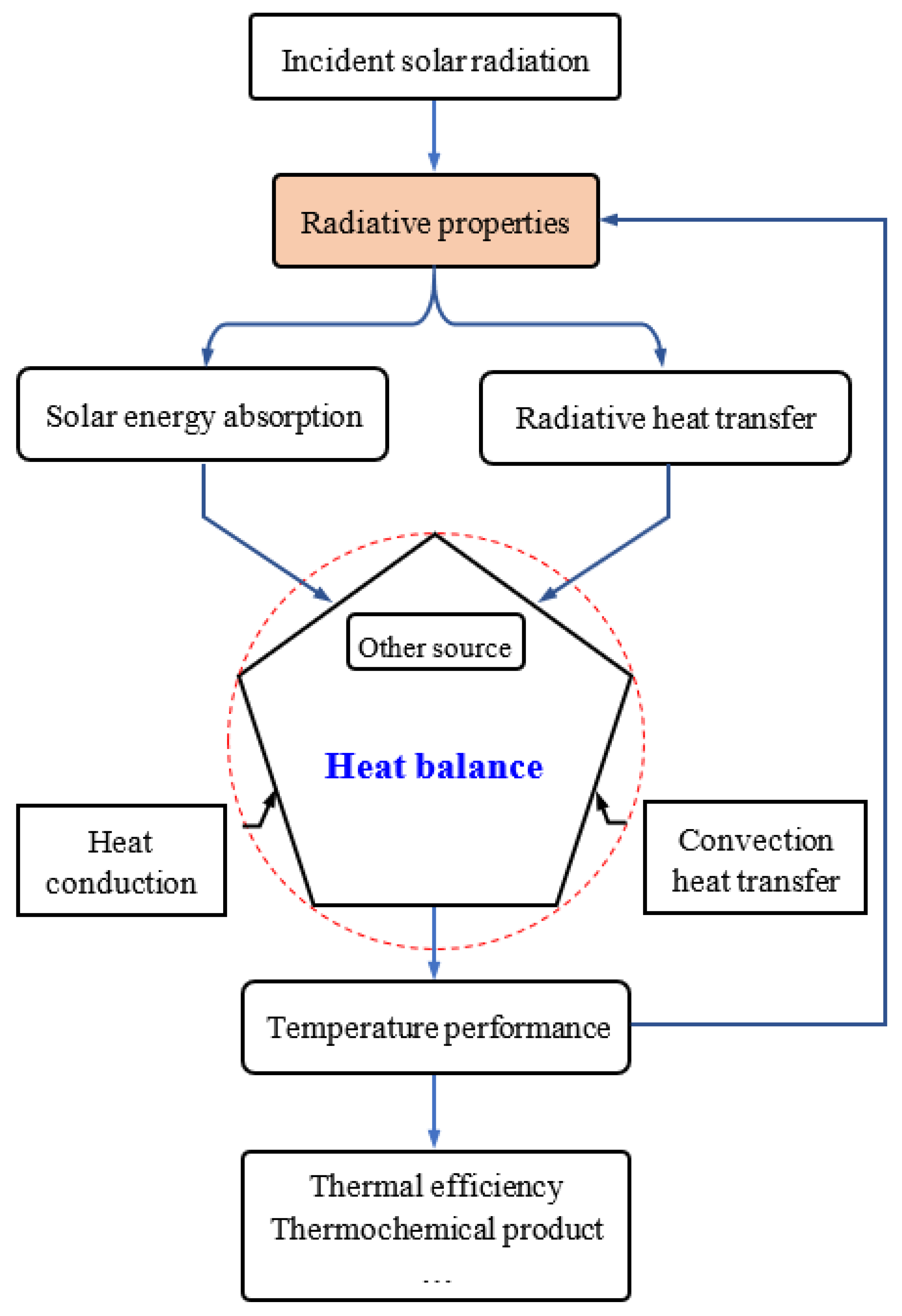


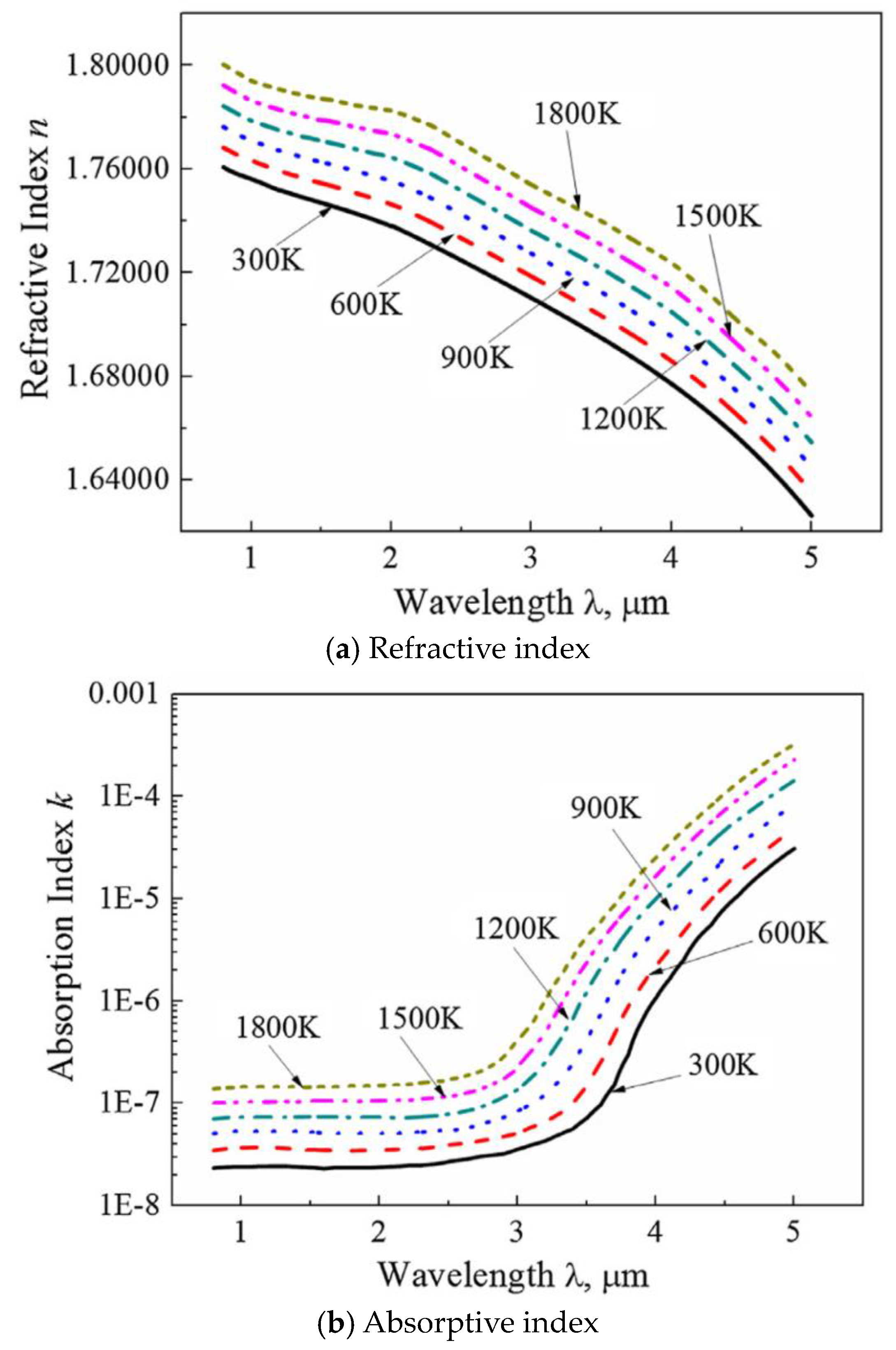
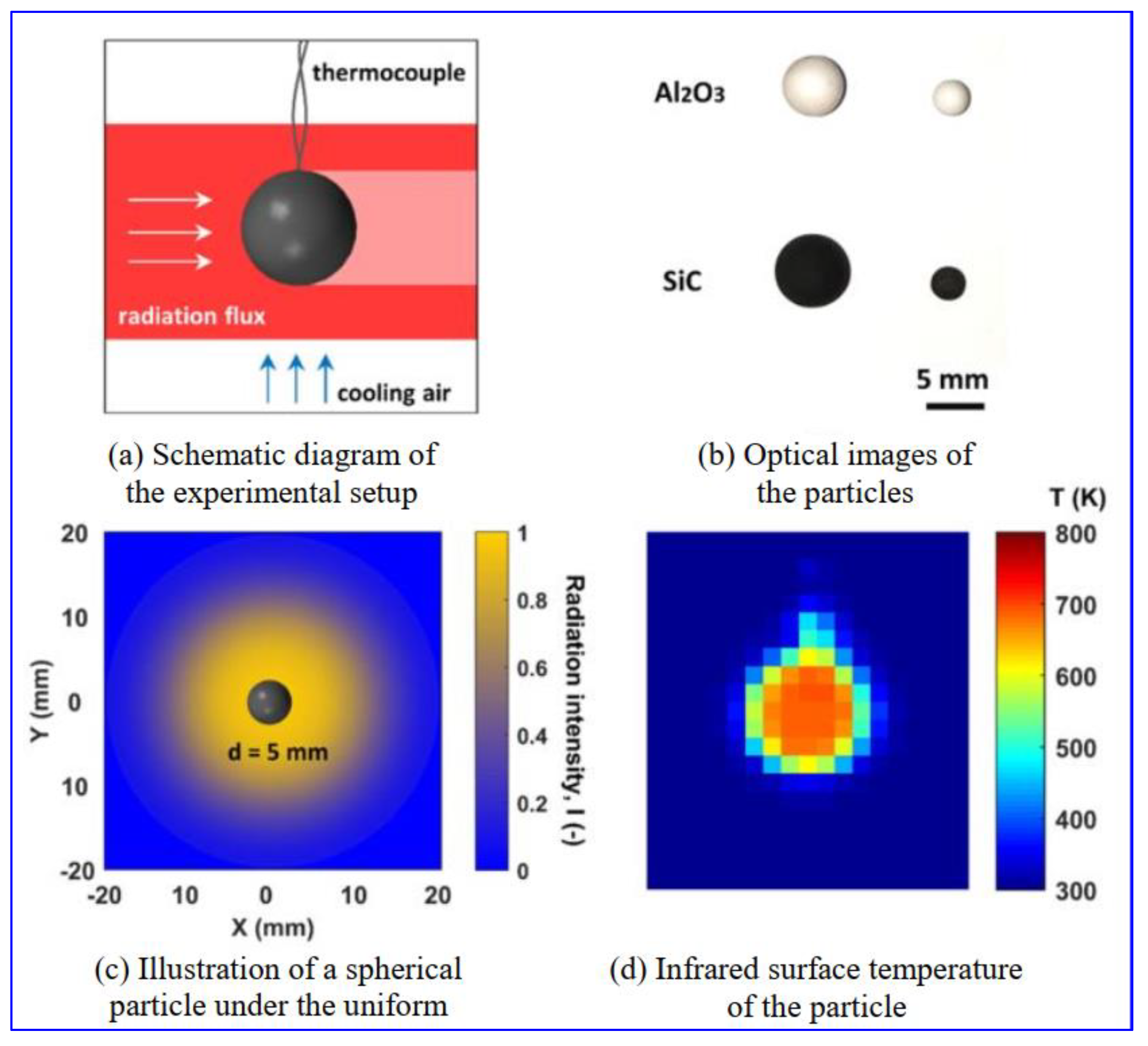




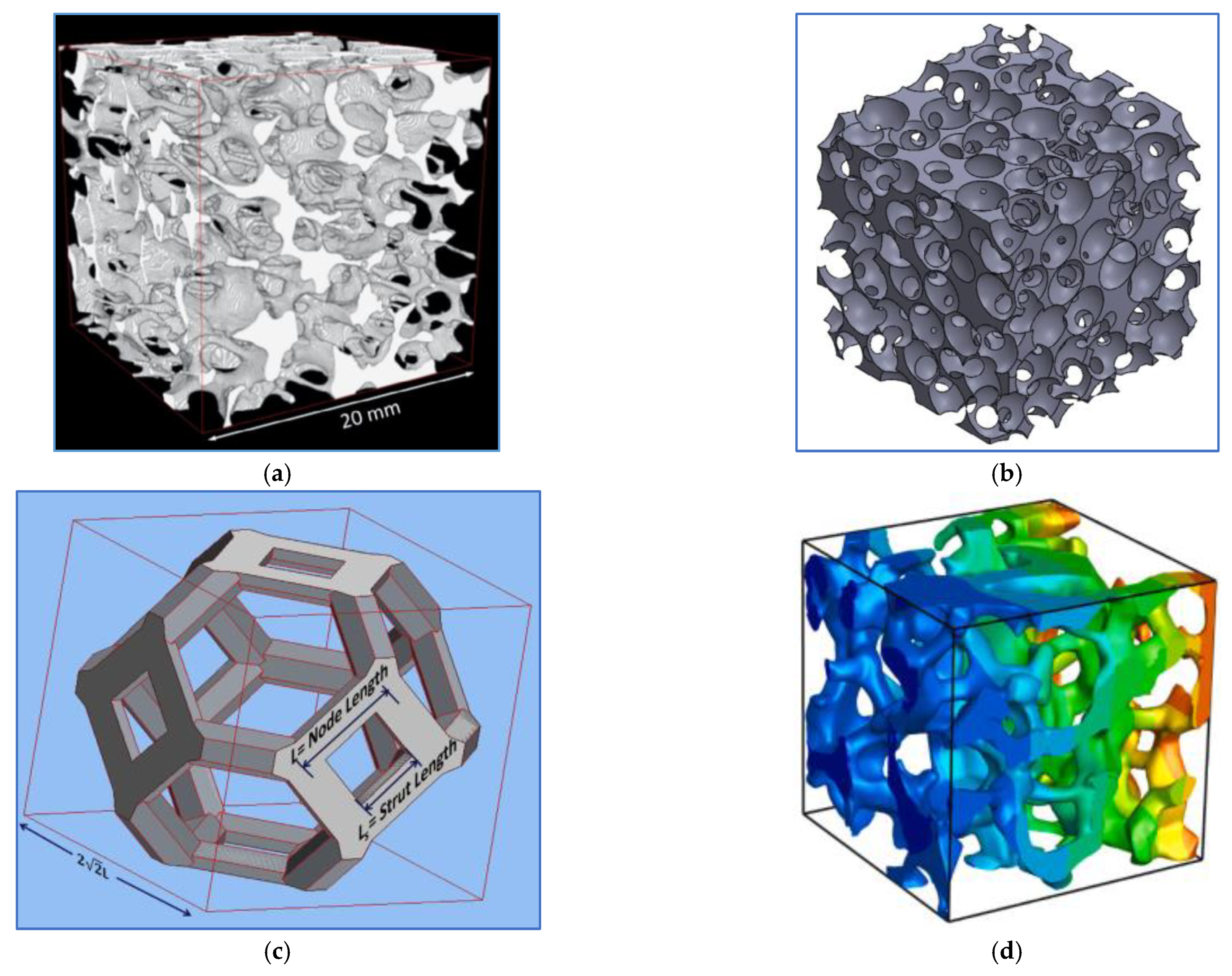
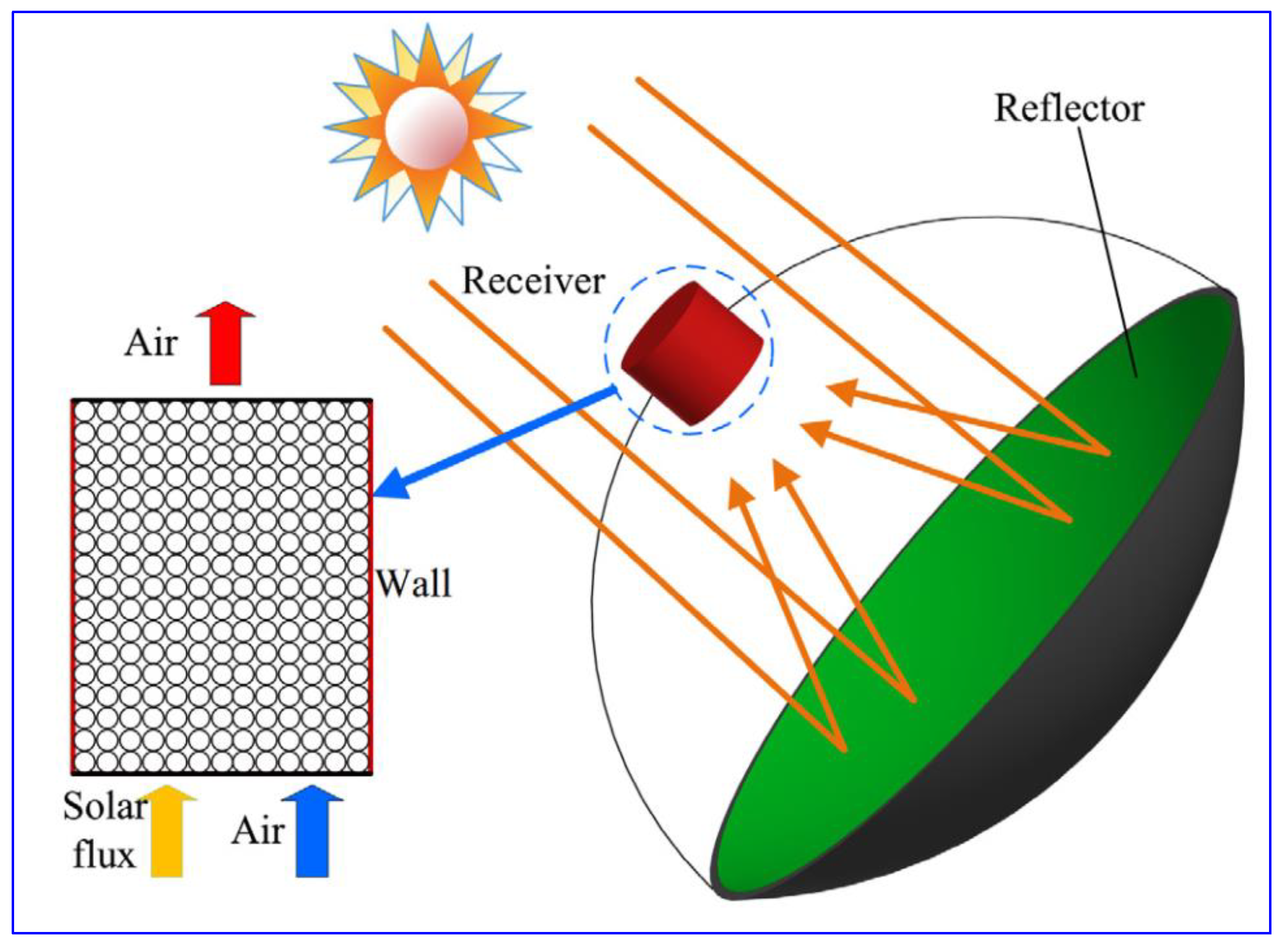


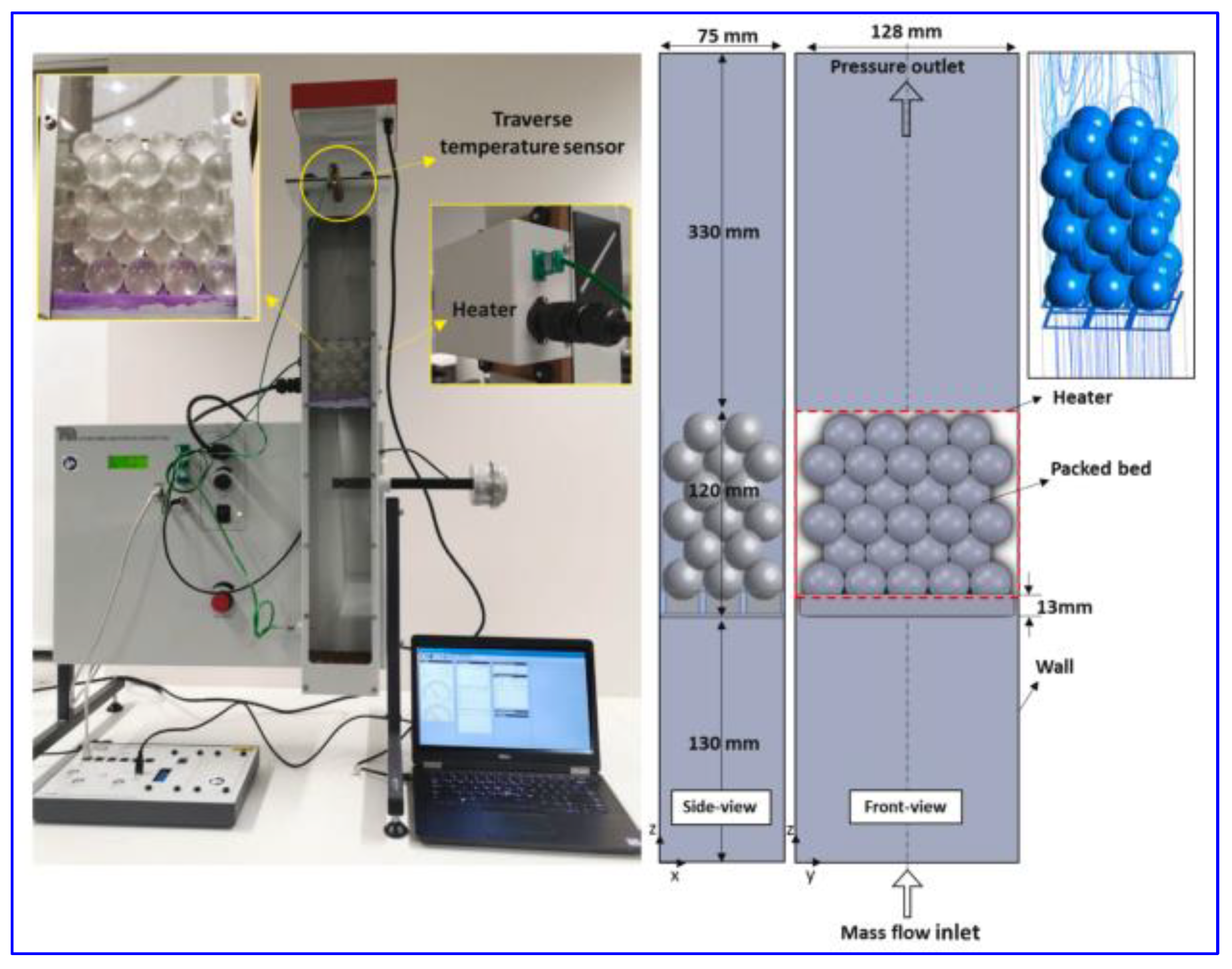
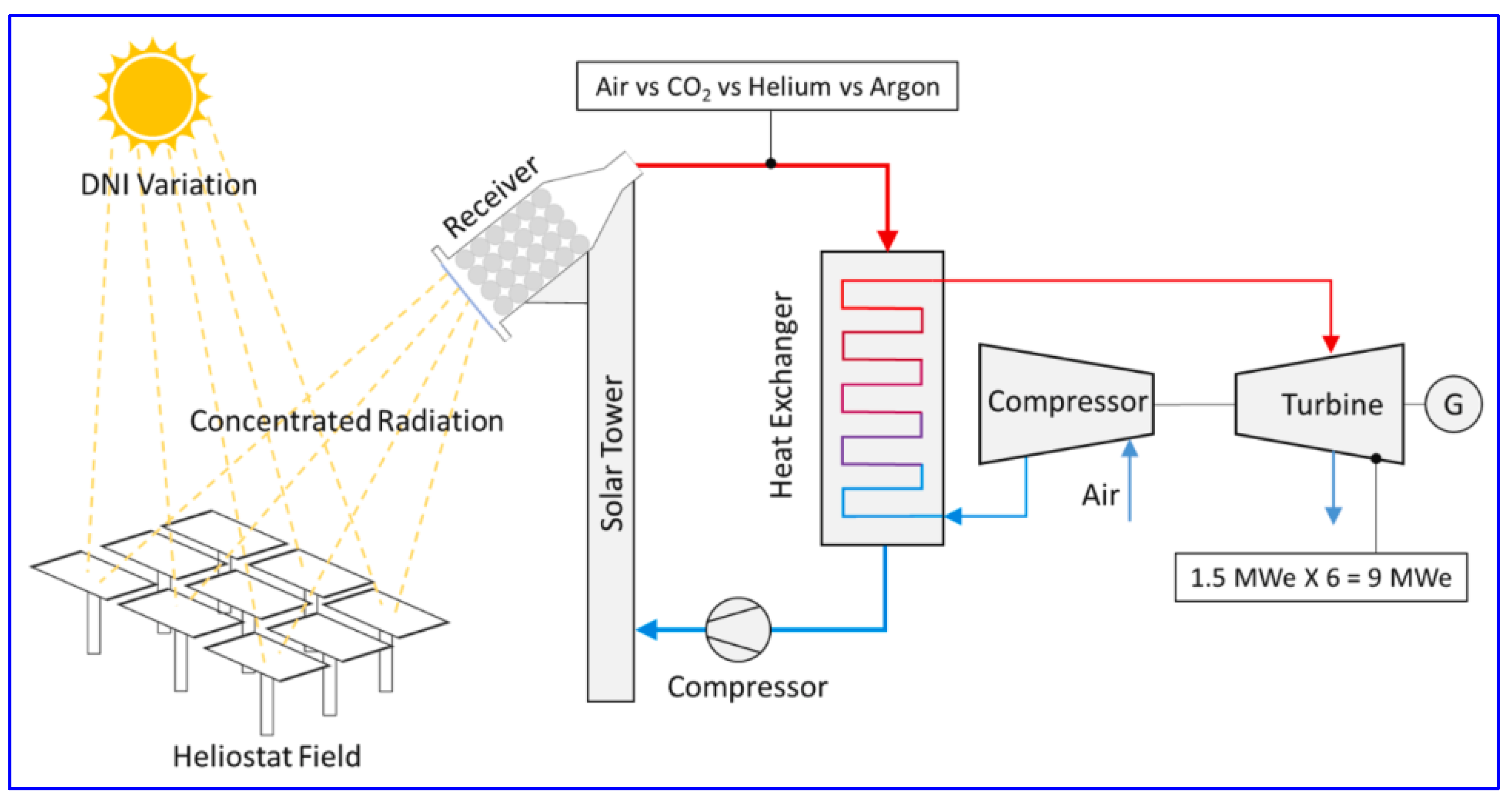
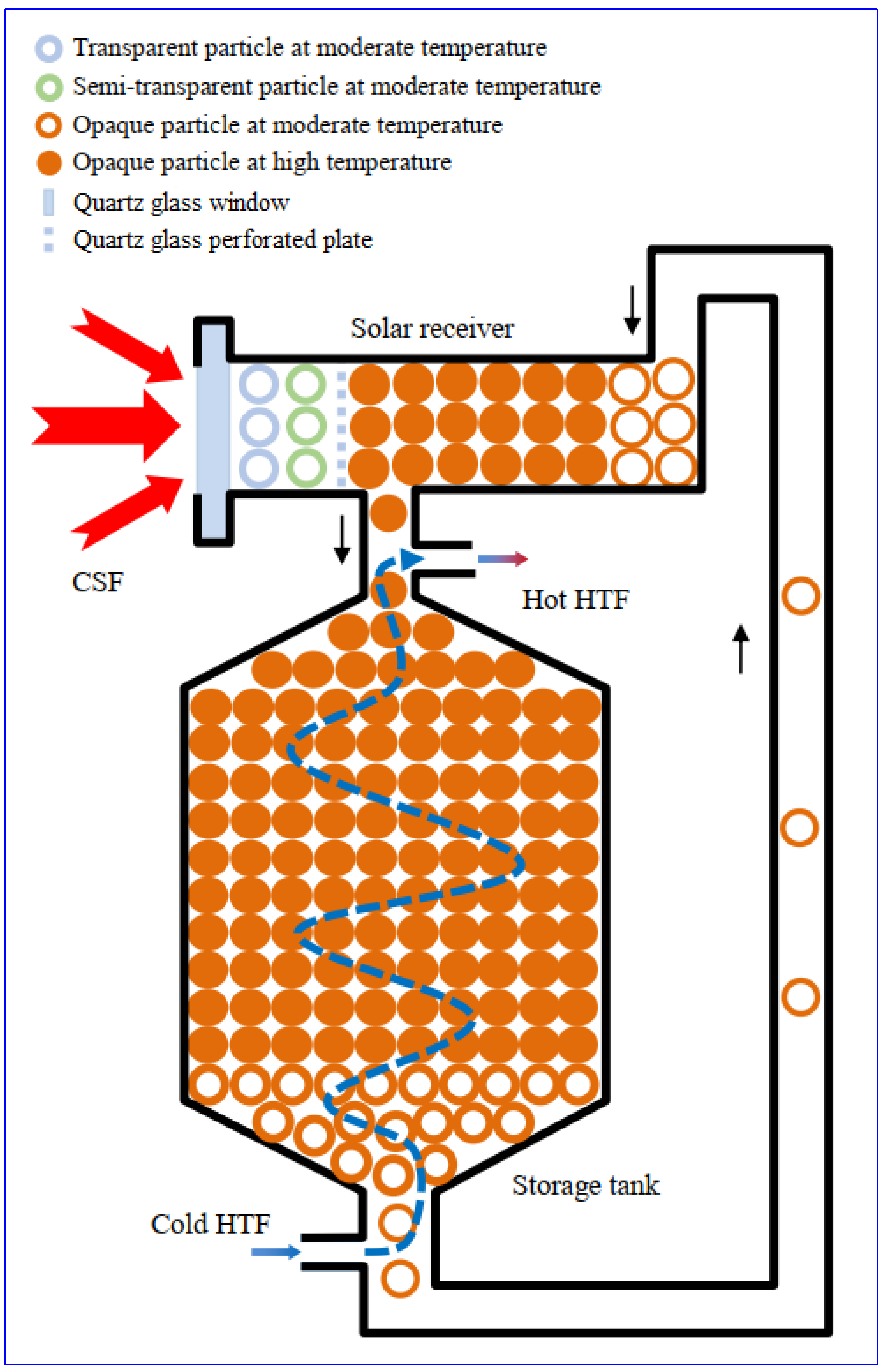
| Methods | Accuracy | Computational Cost | Adaptability | Improvement |
|---|---|---|---|---|
| P1-approximation | Moderate | Low | Moderate optical thickness (β > 5 m−1) | Improve the calculation accuracy on unstructured grids |
| SN-approximation | High | Moderate | Favour optically thin (β < 10 m−1) | Expand the application scope accounting for the variation of radiative properties with temperatures |
| Monte Carlo method | Very high | Very high | Favour uniform medium | Reduce the computational time using an octree data representation and search algorithm |
| Rosseland approximation | Low | Few | Optical thick media (β > 3 m−1) | / |
| Methods | Accuracy | Computational Cost | Adaptability | Recommendation Index |
|---|---|---|---|---|
| Surface absorption model | Low | Low | Optical thick medium (β > 10 m−1) | ★ |
| Exponential decay model | Moderate | Moderate | Moderate optical thickness medium (5 m−1 < β < 10 m−1) | ★★ |
| Volumetric absorption model | High | High | No restriction | ★★★ |
| Models | Approaches | Accuracy | Computational Cost | Application Scenes |
|---|---|---|---|---|
| Discrete particle model | Radiative effective thermal conductivity method | Low | Low | Multiphase flow and heat transfer, or large number of grids |
| Discrete ordinates method | Moderate | Moderate | Heat transfer with moderate quantity of grids (<106) | |
| Surface-to-surface radiation method | High | Very high | Heat transfer with a representative volume section (<104) | |
| Continuous particle model | Rosseland approximation | Low | Low | Multiphase flow and heat transfer, or large number of grids |
| P1 method | Moderate | Moderate | Combined heat transfer with moderate quantity of grids | |
| Discrete ordinates method | High | Quite high | Combined heat transfer with moderate quantity of grids |
Disclaimer/Publisher’s Note: The statements, opinions and data contained in all publications are solely those of the individual author(s) and contributor(s) and not of MDPI and/or the editor(s). MDPI and/or the editor(s) disclaim responsibility for any injury to people or property resulting from any ideas, methods, instructions or products referred to in the content. |
© 2023 by the authors. Licensee MDPI, Basel, Switzerland. This article is an open access article distributed under the terms and conditions of the Creative Commons Attribution (CC BY) license (https://creativecommons.org/licenses/by/4.0/).
Share and Cite
Dai, G.; Huangfu, J.; Wang, X.; Du, S.; Zhao, T. A Review of Radiative Heat Transfer in Fixed-Bed Particle Solar Receivers. Sustainability 2023, 15, 9918. https://doi.org/10.3390/su15139918
Dai G, Huangfu J, Wang X, Du S, Zhao T. A Review of Radiative Heat Transfer in Fixed-Bed Particle Solar Receivers. Sustainability. 2023; 15(13):9918. https://doi.org/10.3390/su15139918
Chicago/Turabian StyleDai, Guilong, Jiangfei Huangfu, Xiaoyu Wang, Shenghua Du, and Tian Zhao. 2023. "A Review of Radiative Heat Transfer in Fixed-Bed Particle Solar Receivers" Sustainability 15, no. 13: 9918. https://doi.org/10.3390/su15139918
APA StyleDai, G., Huangfu, J., Wang, X., Du, S., & Zhao, T. (2023). A Review of Radiative Heat Transfer in Fixed-Bed Particle Solar Receivers. Sustainability, 15(13), 9918. https://doi.org/10.3390/su15139918






